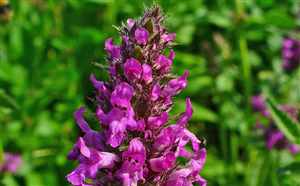Purple betony (Stachys officinalis), Betony, Wood betony, Common hedgenettle, Bishop’s-wort
Main Facts about Purple betony

Using Purple betony
An old remedy for arthritis and gout. Astringent. Slightly bitter (good for digestion) Flowers, leaves and stem used to make tea for anxiety, migraines, gallstones, heartburn, high blood pressure, headache, neuralgia, and to prevent sweating. Strong antioxidant, for use as a general tonic. It can also be used as an ointment for skin ulcers, cuts, sores, and insect bites.Purple betony is a remedy for: Cold and flu, Anxiety
Caution!
Wood betony is a uterine stimulant and should not be used during pregnancy. Excessive doses of the herb also can cause vomiting.Cooking with Purple betony
Tea: 1 teaspoon dried betony leaves cover with 1 cup of boiling water, steep for about 5 minutes. It tastes much like black tea but contains no caffeine. For sore throats and gum inflammations, gargle with the cool tea. Poultice: boil the chopped fresh or dried leaves in a small amount of water for 2 to 5 minutes; strain off the excess liquid, then apply the warm herb to the skin, using a cloth to hold it in place.How to grow Purple betony
Wood betony is a wonderful shade plant. Betony grows easily from seed, root divisions or cuttings. Soil needs to be well drained cannot tolerate waterlogged soil. Prefers a little light rather than total dense shade but is great under trees and even in woodlands provided that the canopy is not fully dense. Once established, it requires little care, other than division every three to four years when the crowns begin to decline. For best quality, collect the aerial parts (leaves, stems and buds) just before the plant flowers.| Pumpkin |
Quinoa
|